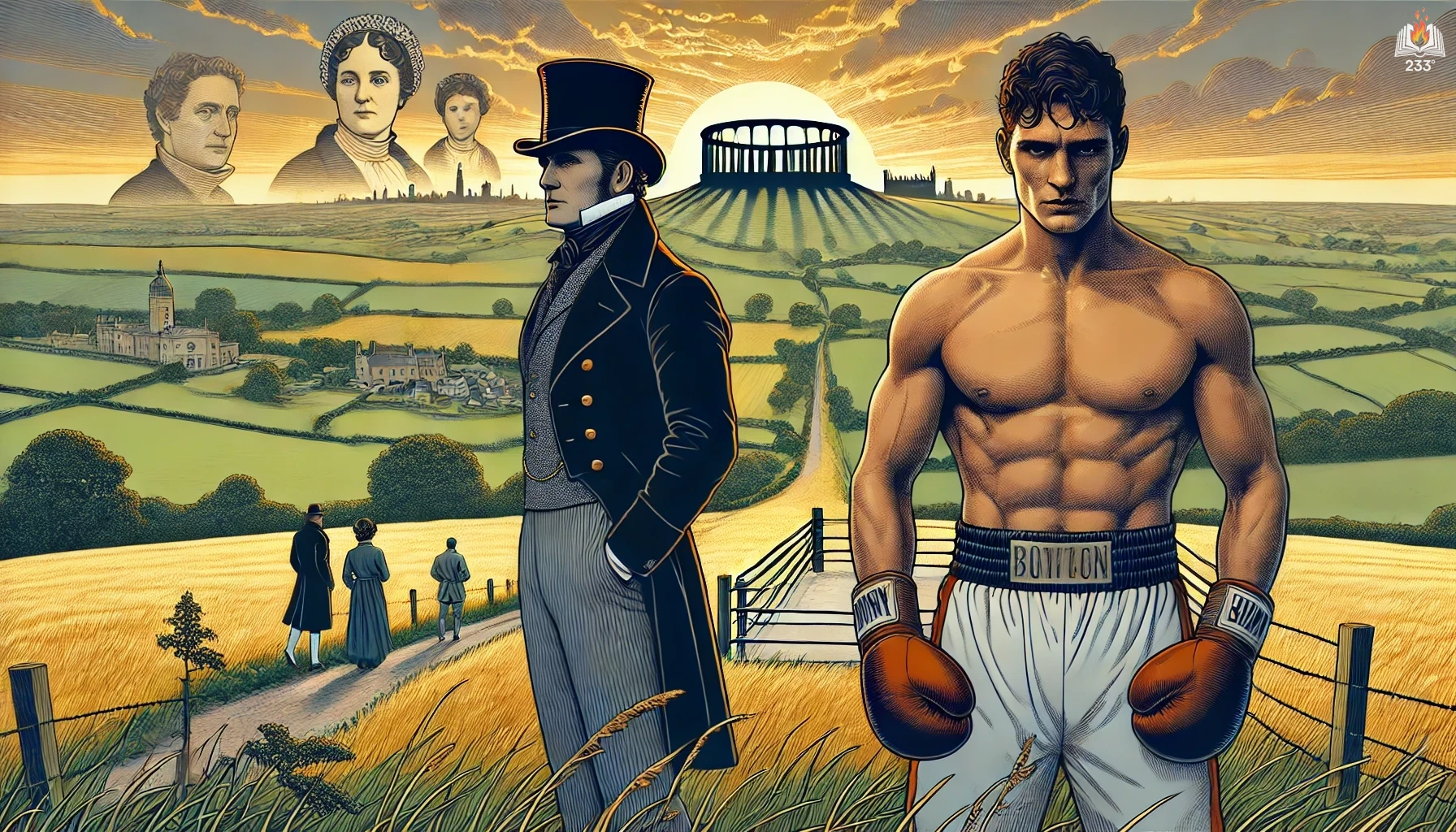The Murder at the Vicarage by Agatha Christie (1930) is the first novel to feature the beloved amateur sleuth Miss Marple, set in the quaint English village of St. Mary Mead. When the detested Colonel Protheroe is found murdered in the vicarage study, the local vicar, Leonard Clement, becomes both narrator and reluctant detective alongside Miss Marple, as the village’s secrets unravel in a web of deception and hidden motives.
Plot Summary
In the quiet village of St. Mary Mead, where lace curtains twitched at every passing cart and no secret stayed buried for long, life at the vicarage unfolded in its usual, if occasionally chaotic, rhythm. The vicar, Leonard Clement, bore the trials of his parish with mild humor, from his wife Griselda’s cheerful irreverence to the persistent meddling of villagers like Miss Marple, who had an uncanny way of noticing the smallest oddities. But the placid surface of village life cracked one Wednesday afternoon with a throwaway remark at the luncheon table – that Colonel Protheroe’s death would be a service to all. No one took it seriously, least of all the vicar himself. Yet within days, those words would echo with chilling weight.
Colonel Lucius Protheroe was a man known for his severity and a touch of cruelty, feared more than loved in St. Mary Mead. His sharp tongue and inflexible nature had earned him enemies aplenty – from his own family to the villagers who crossed his path. When Protheroe arranged to meet the vicar at the rectory to discuss parish accounts, it was little more than another duty on the vicar’s list. But when Clement returned home after an urgent call to a parishioner, he found his study in dreadful stillness. Slumped over the desk was Colonel Protheroe, blood pooling under his head, his life ended by a bullet. The clock, shattered on the desk, marked twenty-two minutes past six – or so it seemed.
The murder swept through the village like wildfire. Inspector Slack arrived from Much Benham, his sharp, restless manner rubbing against the vicar’s gentler ways. The obvious suspects rose swiftly: Anne Protheroe, the colonel’s long-suffering wife, and Lawrence Redding, the young artist with whom she shared stolen glances and whispered promises. Both were seen near the vicarage that evening. Yet suspicion could not be confined to them alone. Lettice Protheroe, the colonel’s daughter, flitted through village life with a distracted air, yet there was something guarded beneath her careless words. And the villagers – Miss Marple, Miss Hartnell, Mrs. Price Ridley – all watched with keen eyes, offering scraps of gossip as clues, their observations sharper than the Inspector’s official methods.
Anne Protheroe had lived in the shadow of her husband’s domination for years. Her sorrow at his death bore the weight of complicated grief – not all mourning is for the person lost, but for what might have been. Her meetings with Lawrence Redding were no longer innocent secrets but public knowledge. Yet even as suspicion tightened around her, Anne remained composed, her grief quiet and contained.
Lawrence Redding, wild-eyed and restless, became a figure of pity and alarm. He admitted to quarreling with the colonel and even offered a confession to the police, desperate to shield Anne. Yet his story frayed under scrutiny. There were too many details left unexplained, too many questions unasked. And in the midst of it all stood Miss Marple, the white-haired lady with gentle hands and penetrating eyes, knitting her way through the investigation as if human nature were a pattern she had long since mastered.
As the investigation deepened, the tangled threads of village life began to unravel. Dr. Stone, the archaeologist excavating a barrow on Protheroe’s land, held his own secrets, his charm shadowed by bursts of temper. His secretary, Miss Cram, with her bright laugh and sharp edges, knew more than she let on. Even the vicar’s young nephew, Dennis, stumbled under the weight of village whispers, struggling with knowledge he feared to voice.
Clues surfaced like bubbles in a still pond. The vicarage clock, always kept a quarter-hour fast, revealed a time of death much later than first assumed, throwing alibis into question. A forged note, left on the desk, hinted at a meeting never intended. A shot heard by none suggested a weapon silenced or skillfully concealed. The village, so small in size, became vast in suspicion.
In the days that followed, a sense of unease crept into the vicarage. Griselda, with her laughing defiance, cast worried glances at her husband. Dennis prowled about, eager and uneasy, while the vicar bore the strain of shepherding a flock fractured by fear. Miss Marple, for her part, gathered truths from half-finished sentences, the glance behind a curtain, the absence of a customary greeting. She understood, better than most, that the heart of a murder often lay not in grand motives but in small, human failings.
The breakthrough came quietly. Miss Marple, piecing together the overlooked details, saw the pattern emerge. The true killer had been hiding in plain sight, their guilt concealed not by cunning, but by the village’s eagerness to look elsewhere. When Inspector Slack finally made the arrest, it was not with a dramatic confrontation, but with the quiet efficiency of a man keen to claim victory, whether or not it was his own discovery.
Anne and Lawrence, freed from the shadow of suspicion, stood at the threshold of a new life, though not without scars. Lettice, for all her dreamy airs, revealed unexpected strength, stepping from the wings into her own uncertain future. The village exhaled, slowly returning to its familiar rhythm, yet changed in ways both seen and unseen.
At the vicarage, peace returned, or something like it. Griselda’s laughter once again filled the rooms, Dennis resumed his teasing, and the vicar allowed himself a moment of quiet reflection. As for Miss Marple, she returned to her garden, pruning roses and observing the comings and goings of the village, her mind ever watchful, ever attuned to the truths others overlooked.
In St. Mary Mead, the murder at the vicarage was already slipping into the folds of memory, retold in whispers over tea, embroidered into the tapestry of village lore. But for those who had stood closest to its shadow, it marked a quiet, irrevocable shift, a reminder that beneath the stillest surfaces, the human heart beats on, carrying its mysteries with it.
Main Characters
Miss Jane Marple: An elderly spinster with razor-sharp observation skills and a deep understanding of human nature. Though underestimated by many, Miss Marple’s quiet wisdom and intuition allow her to piece together the truth behind the murder.
Reverend Leonard Clement: The vicar of St. Mary Mead and the story’s narrator. Kind-hearted and introspective, he grapples with balancing his pastoral duties and his role in the investigation, often revealing his dry wit and frustrations with the village’s gossip.
Griselda Clement: The vicar’s much younger, lively, and unconventional wife. With her playful spirit and occasional tactlessness, Griselda provides both charm and tension in the vicarage, complicating her husband’s life while proving unexpectedly insightful.
Colonel Lucius Protheroe: The murdered man, known for his authoritarian and disagreeable nature. His death surprises no one, as he is widely disliked, yet the mystery lies in uncovering which of his many enemies was driven to kill.
Anne Protheroe: The Colonel’s much younger and quietly suffering second wife. Torn between duty and passion, Anne is a complex figure whose affair with the artist Lawrence Redding casts suspicion upon her.
Lawrence Redding: A passionate young artist entangled in a forbidden romance with Anne Protheroe. Charismatic and impetuous, Lawrence becomes a prime suspect but also evokes sympathy from the vicar.
Lettice Protheroe: The Colonel’s rebellious and vague daughter from his first marriage. Her drifting nature and sharp tongue conceal a deeper emotional turmoil and resentment.
Theme
Appearances vs. Reality: The novel explores how outward respectability masks hidden desires, resentments, and secrets. Behind the village’s idyllic façade lurk jealousy, betrayal, and unspoken tensions, making every character a potential suspect.
Justice and Morality: Christie raises questions about the nature of justice – whether moral failings justify harsh punishment, and how the law intersects with human fallibility. The vicar’s reflections on justice and mercy bring depth to the narrative.
The Nature of Gossip: Village gossip operates as both a social glue and a dangerous weapon. The way characters speculate, whisper, and judge one another reflects on the destructive power of idle talk and the vulnerability of reputation.
The Limits of Authority: Figures of authority, from Colonel Protheroe to Inspector Slack, are frequently flawed or ineffective. In contrast, Miss Marple’s informal yet precise detective work highlights the limitations of official power and the potency of quiet intelligence.
Writing Style and Tone
Agatha Christie’s writing style in this novel is marked by crisp dialogue, subtle irony, and a mastery of misdirection. She balances vivid character portraits with a tightly plotted mystery, maintaining reader engagement through clever clues and red herrings. Christie’s prose is accessible yet sophisticated, inviting readers into the seemingly tranquil village life while gradually peeling back its layers.
The tone of the novel is a blend of light-hearted domestic comedy and darker psychological intrigue. While the vicar’s dry humor and Griselda’s irreverence provide moments of levity, the novel also delves into the undercurrents of human passion, jealousy, and despair. Christie maintains an atmosphere of suspense throughout, skillfully shifting between village charm and murder mystery tension.
We hope this summary has sparked your interest and would appreciate you following Celsius 233 on social media:
There’s a treasure trove of other fascinating book summaries waiting for you. Check out our collection of stories that inspire, thrill, and provoke thought, just like this one by checking out the Book Shelf or the Library
Remember, while our summaries capture the essence, they can never replace the full experience of reading the book. If this summary intrigued you, consider diving into the complete story – buy the book and immerse yourself in the author’s original work.
If you want to request a book summary, click here.
When Saurabh is not working/watching football/reading books/traveling, you can reach him via Twitter/X, LinkedIn, or Threads
Restart reading!








